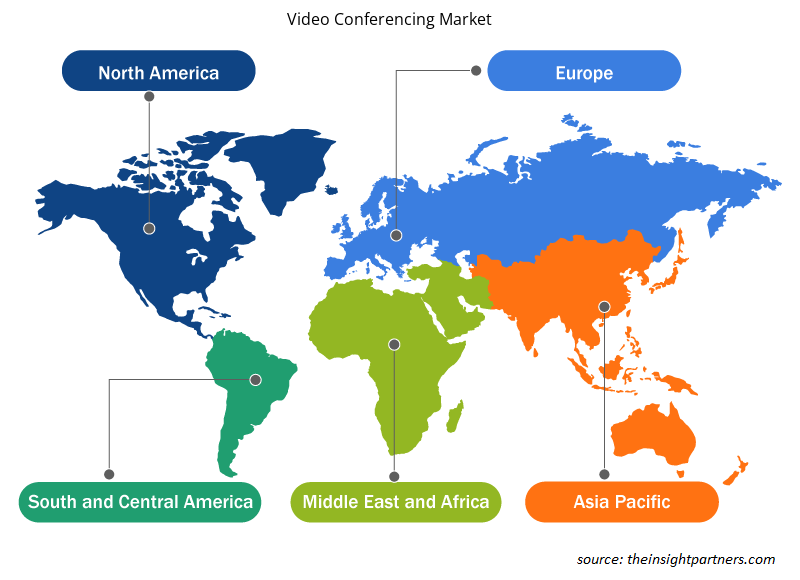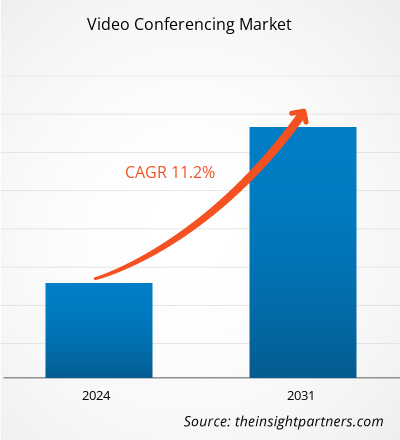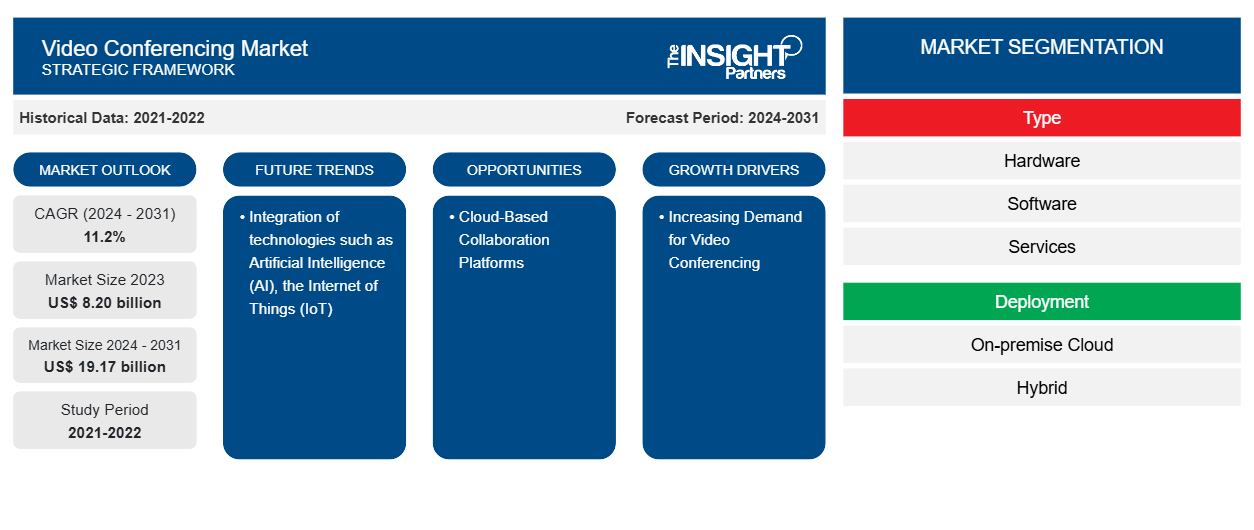全球视频会议市场规模预计将从 2023 年的 82 亿美元增长到 2031 年的 191.7 亿美元;预计从 2024 年到 2031 年的复合年增长率为 11.2%。人工智能 (AI)、物联网 (IoT) 和云技术等技术的融合很可能仍是视频会议市场的关键趋势。
视频会议市场分析
远程工作和虚拟团队的兴起推动了对视频会议解决方案的需求。视频会议使地理上分散的团队能够进行有效的沟通和协作,从而导致组织越来越多地采用视频会议。
视频会议市场概况
视频会议是一种功能强大的工具,它使个人和团队无论身在何处都能远程连接和协作。它利用音频和视频技术创建虚拟会议,使参与者能够实时交流,就像在同一个房间一样。这项技术通过促进无缝沟通、提高生产力和促进全球协作,彻底改变了企业的运营方式。在快节奏的商业世界中,视频会议已成为各种规模组织的必备工具。它消除了距离和时间的障碍,使专业人士无需出差即可进行面对面的会议。这不仅节省了宝贵的时间,还降低了与交通、住宿和其他后勤费用相关的成本。
定制此报告以满足您的需求
您可以免费定制任何报告,包括本报告的部分内容、国家级分析、Excel 数据包,以及为初创企业和大学提供优惠和折扣
-
获取此报告的关键市场趋势。这个免费样品将包括数据分析,从市场趋势到估计和预测。
视频会议市场驱动因素和机遇
视频会议需求增长利好市场
近年来,对视频会议解决方案的需求一直在稳步增长。这种增长可以归因于几个因素,包括对实时视频会议和个人与团队之间协作的需求。远程工作和地理分散的业务运营的新兴趋势推动了对视频会议解决方案的需求增加。随着越来越多的人在家或在不同地点工作,视频会议提供了一种方便有效的连接和协作方式。视频通信解决方案使大型企业能够提高运营效率并提供更好的客户体验。这些解决方案促进了位于不同地点的员工之间的协作,使团队能够无缝协作。
基于云的协作平台
基于云的协作平台因其灵活性、可扩展性和易用性而在企业和组织中越来越受欢迎。这些平台利用云技术实现实时通信、文档共享和项目管理。云协作平台允许团队成员通过实时评论、聊天和视频会议即时协作和分享想法。这种灵活性使团队无论身在何处都能一起工作,从而使远程团队或不同城市的团队更容易有效协作。
视频会议市场报告细分分析
有助于推导视频会议市场分析类型、部署和行业垂直的关键部分。
- 根据类型,市场分为硬件、软件和服务。2023 年,硬件部分占据了更大的市场份额。
- 根据部署,市场分为本地云和混合云。本地云部分在 2023 年占据了更大的市场份额。
- 根据行业垂直度,市场分为企业、政府和国防、医疗保健、教育、制造业和其他。企业部门在 2023 年占据了更大的市场份额。
按地区划分的视频会议市场份额分析
视频会议市场报告的地理范围主要分为五个地区:北美、亚太地区、欧洲、中东和非洲以及南美/南美和中美。2023 年,北美占据了视频会议市场的主导地位。北美大型风电场和大型太阳能项目的存在促进了 IGBT 市场的增长。IGBT 用于可再生能源系统的电源转换器,例如风力涡轮机和太阳能逆变器。
视频会议市场区域洞察
Insight Partners 的分析师已详尽解释了预测期内影响视频会议市场的区域趋势和因素。本节还讨论了北美、欧洲、亚太地区、中东和非洲以及南美和中美洲的视频会议市场细分和地理位置。

- 获取视频会议市场的区域特定数据
视频会议市场报告范围
| 报告属性 | 细节 |
|---|---|
| 2023 年的市场规模 | 82亿美元 |
| 2031 年市场规模 | 191.7亿美元 |
| 全球复合年增长率(2024 - 2031) | 11.2% |
| 史料 | 2021-2022 |
| 预测期 | 2024-2031 |
| 涵盖的领域 |
按类型
|
| 覆盖地区和国家 |
北美
|
| 市场领导者和主要公司简介 |
|
市场参与者密度:了解其对商业动态的影响
视频会议市场正在快速增长,这得益于终端用户需求的不断增长,而这些需求又源于消费者偏好的不断变化、技术进步以及对产品优势的认识不断提高等因素。随着需求的增加,企业正在扩大其产品范围,进行创新以满足消费者的需求,并利用新兴趋势,从而进一步推动市场增长。
市场参与者密度是指在特定市场或行业内运营的企业或公司的分布情况。它表明相对于给定市场空间的规模或总市场价值,有多少竞争对手(市场参与者)存在于该市场空间中。
在视频会议市场运营的主要公司有:
- Adobe 系统公司
- 飞涨
- Avaya 公司
- 思科系统公司
- 谷歌
- 华为投资控股有限公司
免责声明:上面列出的公司没有按照任何特定顺序排列。

- 获取视频会议市场顶级关键参与者的概述
视频会议市场新闻和最新发展
视频会议市场通过收集一手和二手研究的定性和定量数据进行评估,其中包括重要的公司出版物、协会数据和数据库。以下是市场发展情况的列表:
- 2024 年 3 月,Google Meet 推出了一项专为虚拟会议设计的先进肖像修饰功能。这项创新功能让用户能够通过“细微修饰”和“平滑”设置来增强自己的形象,确保外观专业而精致。通过增强用户的信心,此功能有助于实现无缝且专业的在线会议体验。Business Standard、Education Plus 和 Google Workspace Individual 用户均可使用此功能,让他们能够在虚拟互动中以最佳状态展示自己。
(来源:谷歌,新闻稿,2024 年)
视频会议市场报告覆盖范围和交付成果
“视频会议市场规模和预测(2021-2031)”报告对以下领域进行了详细的市场分析:
- 范围内所有主要细分市场的全球、区域和国家层面的市场规模和预测
- 市场动态,如驱动因素、限制因素和关键机遇
- 未来主要趋势
- 详细的 PEST/波特五力分析和 SWOT 分析
- 全球和区域市场分析涵盖关键市场趋势、主要参与者、法规和最新市场发展
- 行业格局和竞争分析,涵盖市场集中度、热点图分析、知名参与者和最新发展
- 详细的公司简介
- 历史分析(2 年)、基准年、预测(7 年)及复合年增长率
- PEST和SWOT分析
- 市场规模、价值/数量 - 全球、区域、国家
- 行业和竞争格局
- Excel 数据集
近期报告
客户评价
购买理由
- 明智的决策
- 了解市场动态
- 竞争分析
- 客户洞察
- 市场预测
- 风险规避
- 战略规划
- 投资论证
- 识别新兴市场
- 优化营销策略
- 提升运营效率
- 顺应监管趋势























 获取免费样品 - 视频会议市场
获取免费样品 - 视频会议市场